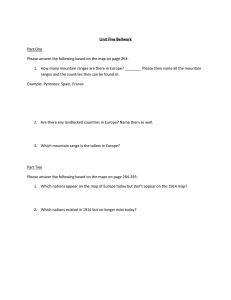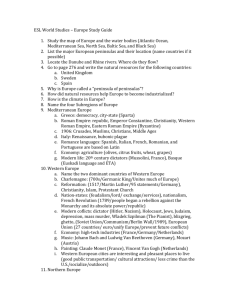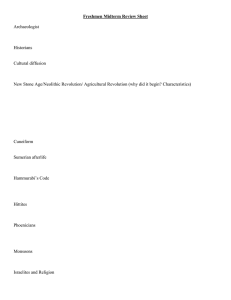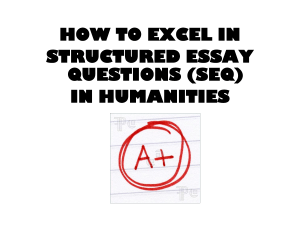Bellwork – Unit 5: Europe! 1
advertisement
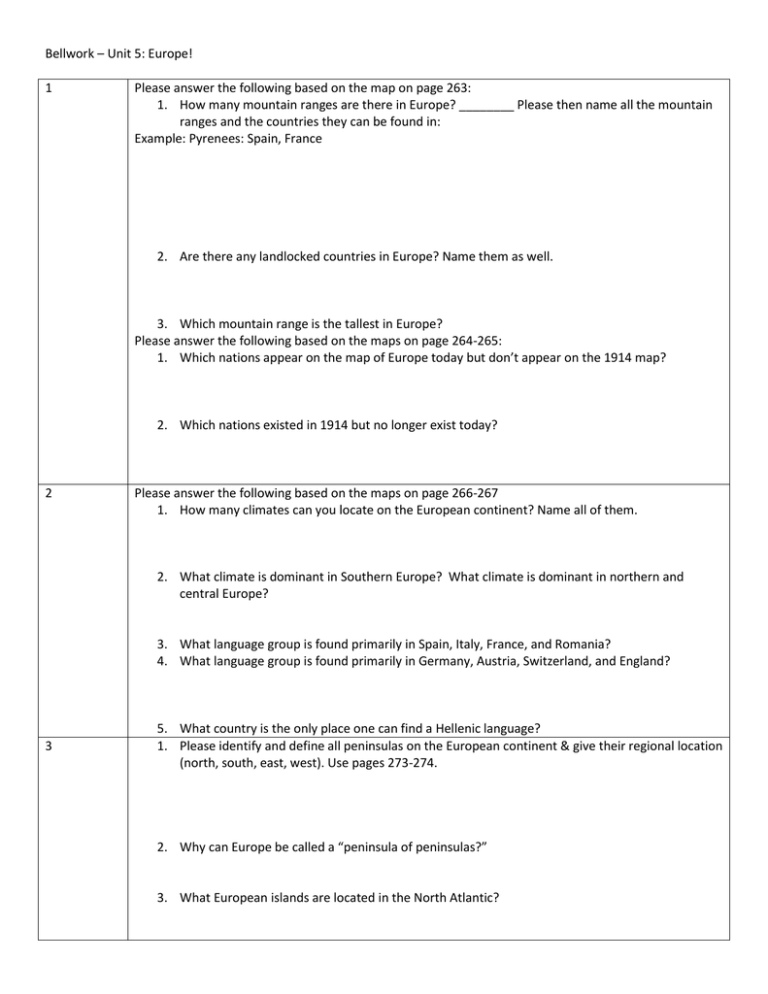
Bellwork – Unit 5: Europe! 1 Please answer the following based on the map on page 263: 1. How many mountain ranges are there in Europe? ________ Please then name all the mountain ranges and the countries they can be found in: Example: Pyrenees: Spain, France 2. Are there any landlocked countries in Europe? Name them as well. 3. Which mountain range is the tallest in Europe? Please answer the following based on the maps on page 264-265: 1. Which nations appear on the map of Europe today but don’t appear on the 1914 map? 2. Which nations existed in 1914 but no longer exist today? 2 Please answer the following based on the maps on page 266-267 1. How many climates can you locate on the European continent? Name all of them. 2. What climate is dominant in Southern Europe? What climate is dominant in northern and central Europe? 3. What language group is found primarily in Spain, Italy, France, and Romania? 4. What language group is found primarily in Germany, Austria, Switzerland, and England? 3 5. What country is the only place one can find a Hellenic language? 1. Please identify and define all peninsulas on the European continent & give their regional location (north, south, east, west). Use pages 273-274. 2. Why can Europe be called a “peninsula of peninsulas?” 3. What European islands are located in the North Atlantic? 4 1. Please identify and define the following terms using Section 2 of Chapter 12: a. North Atlantic Drift b. Sirocco c. Mistral 2. Please answer the following questions using pages 282-284: a. Where is the city of Venice? b. What type of environment is the city of Venice built upon? c. Why is water so important to Venice? d. What problems does Venice face today? 5 Please turn to pages 288-290 to answer the following questions: 1. Which two civilizations are described as the greatest of ancient Europe? 2. Make a brief timeline of the first great civilization (from #1). Give 4 dates from your book. ____________________________________________________________________ 3. Make a brief timeline of the second great civilization (from #1). Give 4 dates from your book. ______________________________________________________________________________ 4. What modern day countries would fit within the boundaries of the Roman Empire? Compare the maps on page 290 and 288 and name all 22 of them. Hint: also count the small countries on page 288! 5. What is the difference between a democracy and a republic? 6 1. Use all the dates from page 288-291 to create a master timeline of Mediterranean Europe from the Classical Era through the Renaissance: _______________________________________________________________________________ 2. Look at page 294 and answer the following questions: a. What brought the plague to Europe? b. At what southern European city did the plague first enter Europe? c. How was the plague spread? d. How severe was the devastation caused by the plague (how many people died)? 3. Please turn to page 296-297 to answer the following: a. Which Germanic king tried to revive the Roman Empire and unite much of Europe? Roughly when did he rule? b. Define feudalism in 6 words exactly: c. What is a nation-state? d. How does a nation-state differ from a city-state (p.289)? 4. Please turn to page 299 to answer the following: a. Look at the maps at the top of p. 299. i. What is the relative location of business centers in FRA/GER? ii. Use the Unit Atlas to find the border between FRA & GER. Which French & German cities would make good trading partners? 7 Please look at pages 302-303 to answer the following: 1. What are the Nordic countries? 2. What type of tribes invaded the Roman Empire and took Rome? 3. Who were the Vikings? What areas of Europe did they conquer? 4. Who was William the Conqueror? 5. What countries compose the United Kingdom? 8 Please look at page 303-304 to answer the following: 1. What is a parliament? 2. What document brought about the idea of a parliament to England? When was it written? 3. What types of political ideas did this lawmaking document have? 9 1. Eastern Europe is a cultural crossroad. Exactly what does that term mean? 2. Define the term balkanization. What area of Europe has ‘the Balkans?’ 3. After what year did Eastern Europe start moving towards a market economy? What massive, multi-national empire controlled Eastern Europe before that year? What was its style of government? 4. Define the term ‘satellite nation’ in 6 words!
